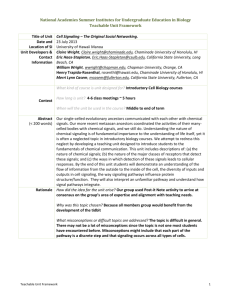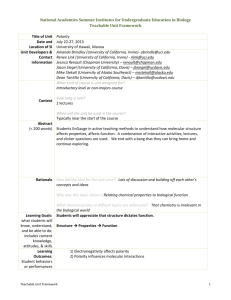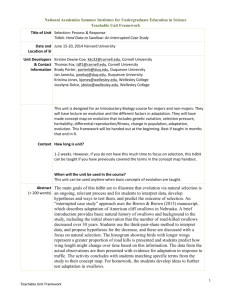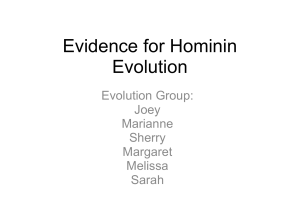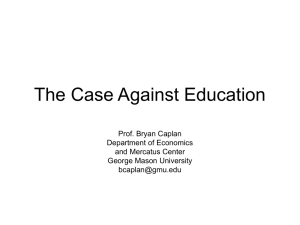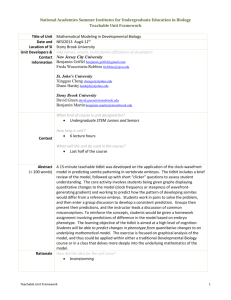Connecting Gene Expression, Cell Signaling, and Morphology
advertisement
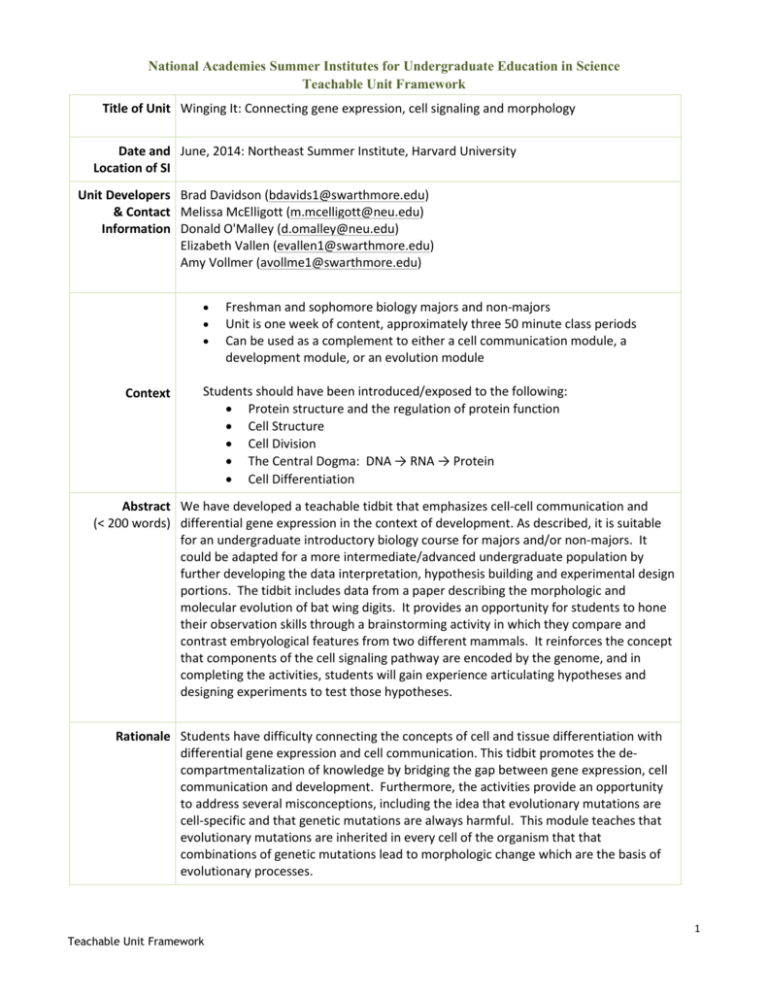
National Academies Summer Institutes for Undergraduate Education in Science Teachable Unit Framework Title of Unit Winging It: Connecting gene expression, cell signaling and morphology Date and June, 2014: Northeast Summer Institute, Harvard University Location of SI Unit Developers Brad Davidson (bdavids1@swarthmore.edu) & Contact Melissa McElligott (m.mcelligott@neu.edu) Information Donald O'Malley (d.omalley@neu.edu) Elizabeth Vallen (evallen1@swarthmore.edu) Amy Vollmer (avollme1@swarthmore.edu) Context Freshman and sophomore biology majors and non-majors Unit is one week of content, approximately three 50 minute class periods Can be used as a complement to either a cell communication module, a development module, or an evolution module Students should have been introduced/exposed to the following: Protein structure and the regulation of protein function Cell Structure Cell Division The Central Dogma: DNA → RNA → Protein Cell Differentiation Abstract We have developed a teachable tidbit that emphasizes cell-cell communication and (< 200 words) differential gene expression in the context of development. As described, it is suitable for an undergraduate introductory biology course for majors and/or non-majors. It could be adapted for a more intermediate/advanced undergraduate population by further developing the data interpretation, hypothesis building and experimental design portions. The tidbit includes data from a paper describing the morphologic and molecular evolution of bat wing digits. It provides an opportunity for students to hone their observation skills through a brainstorming activity in which they compare and contrast embryological features from two different mammals. It reinforces the concept that components of the cell signaling pathway are encoded by the genome, and in completing the activities, students will gain experience articulating hypotheses and designing experiments to test those hypotheses. Rationale Students have difficulty connecting the concepts of cell and tissue differentiation with differential gene expression and cell communication. This tidbit promotes the decompartmentalization of knowledge by bridging the gap between gene expression, cell communication and development. Furthermore, the activities provide an opportunity to address several misconceptions, including the idea that evolutionary mutations are cell-specific and that genetic mutations are always harmful. This module teaches that evolutionary mutations are inherited in every cell of the organism that that combinations of genetic mutations lead to morphologic change which are the basis of evolutionary processes. Teachable Unit Framework 1 National Academies Summer Institutes for Undergraduate Education in Science Teachable Unit Framework Learning Goals: broad aims of the lesson or Learning Objectives: Specific and measurable unit; what will students understand at end of the unit. statements of what students will be able to do to demonstrate mastery of the learning goals. (You might write multiple objectives for a single learning goal. You could label these as 1a, 1b, 1c, etc.) Example: students will understand the flow of information from DNA to proteins. Example: students will be able to predict changes to protein sequence that results from DNA mutations. 1. Understand the basic principles of cell signaling and signal transduction. (this learning goal would be part of the larger teachable unit, and is not specifically addressed by this tidbit) 2. Understand how cell signaling takes place across different temporal and spatial scales (e.g. within a tissue, an organ, organism, or developing organism). (this learning goal would be part of the larger teachable unit, and is not specifically addressed by this tidbit) 3 Understand how cell signaling impacts differential gene expression and morphology. 3a. Apply your knowledge of the Central Dogma to a cell signaling pathway. 3b. Predict how a mutation in a cell signaling pathway can lead to a developmental change. 3c. Practice careful observation and description. Teachable Unit Framework 2 National Academies Summer Institutes for Undergraduate Education in Science Teachable Unit Framework Incorporation of Scientific Teaching Themes Active Learning Assessment Inclusivity How students will engage actively in learning the concepts (what types of How teachers will measure learning; how students will self-evaluate learning (what types of assessments are How the unit is designed to include participants with a variety of experiences, abilities, and characteristics activities will they engage in?) used?) Activities outside of class: Pre-assessments: BMB signaling and bone growth review (optional) Multiple choice question emphasizing how mutations in components of BMP signaling pathway could affect bone growth. Activities during class: Embedded Assessments: 1. Practice observation skills: contrast features of mouse and bat embryos. 1. Reflection, writing, followed by group share*. 2. Diagram simple cell signaling pathway. 3. Group share: using a handout that has the diagram from the left side of Slide #27, illustrate hypothesis for how changes in BMP signaling pathway could have led to elongation of hand bones in bat. This figure has been included as a separate ppt file for easy instructor modification if necessary. Teachable Unit Framework The activity is based on a paper that includes several authors, 2. Diagram/illustration*. some of whom are females. Pictures of the authors are 3. Think, pair, share; then group shown to demonstrate the share diagram/illustration of diversity of scientists. hypothesis. The activities include observation, illustration, and *Formative assessment - index cards group sharing, and accommodate a variety of that have writing from item 1 and diagram from item 2 may be collected learning styles. to provide formative assessment regarding students’ observational abilities and retrieval of signal transduction model. This is easily done with one index card-having item 1 answers on one side and item 2 answers on the other. 3 National Academies Summer Institutes for Undergraduate Education in Science Teachable Unit Framework Activities after class: 1. Summarize 2 alternative hypotheses 3. Describe (in one sentence) an experiment that distinguishes between these 3. Briefly describe the results you would expect that would support each hypothesis Summative assessments: Homework - would be uploaded to course discussion board and could be assessed (graded). Class Presentation Plan (general class schedule with approximate timing for unit) Session 1 Time (min) Learning Objectives Activity/assessment Preclass Objective for this assignments segment: Students /activities will review BMP student time signaling pathway. needed 15 min introductory Objective for this material segment: Students presentation will practice careful class time for observation. this segment 5 min Teachable Unit Framework Explanation, notes, suggestions, tips Assessment: Multiple Suggestion for pre-class assignment and multiple choice question choice assessment are included in the attached emphasizing how PowerPoint presentation. mutations in components of BMP signaling pathway could affect bone growth. Activity for this segment: Students are observing bat and mouse embryos, teacher facilitating group discussion about differences in embryo morphology. All images are included in the attached PowerPoint presentation. 4 National Academies Summer Institutes for Undergraduate Education in Science Teachable Unit Framework learning Objective for this activity #1 segment: Students class time for should be able to this segment diagram simple cell Activity for this segment: Diagramming a simple cell signaling pathway. This can activity can be done in a multitude of ways: individually, as a think-pair-share, a strip sequence, or a concept map. signaling pathway 5 min that includes two cells, a signal, a receptor, and an output. learning Objective for this activity #2 segment: students Activity for this segment: Making changes to depict would be able to changes to BMP signaling class time for this segment illustrate a hypothesis pathway using worksheet that explains how (attached as PDF) 5 min changes in BMP signaling pathway could have led to elongation of hand bones in bat. post-activity Objective for this summing up segment: students or transition will evaluate the class time for hypotheses they this segment came up with in the second learning 15-30 min activity. Next activity Objective for this or class segment: students segment will be able to class time for this segment Homework-out of class propose an experiment to test the hypothesis they proposed in the previous learning activity. Teachable Unit Framework Group share/discussion This activity can be done in a Think-Pair-Share. Students can individually develop and record hypotheses, illustrate their hypotheses in their worksheet and then share their hypotheses with a partner. Each partner group should discuss their hypotheses and ensure that they have 2 different hypotheses between them. Circulate to identify possible misconceptions and clarify questions. Ensure that students are identifying BOTH the point in the cell communication pathway that may have been altered and where in the genome the mutation has occurred (for example, cell 1, cell 2 or BOTH). Activities: students are Uploaded homework could be assessed (graded) asked to: 1. Summarize 2 alternate hypotheses 2. Describe (in one sentence) an experiment that distinguishes between them. 3. Briefly describe the results you would expect that would support each hypothesis 4. Upload to the class discussion board 5 National Academies Summer Institutes for Undergraduate Education in Science Teachable Unit Framework Additional Next class activity could activities include discussion of PDF of publication is attached. published experiment. If there are multiple activities or segments or class sessions, add additional rows and activities information as needed Resources for Teaching the Unit -PowerPoint file is attached. -PDF of publication is attached. -PowerPoint files of cell signaling figure is attached for instructor modification. -Worksheet on cell signaling is attached. -notecards for diagramming cell signaling pathway are optional. Acknowledgements We would like to thank Tom Torello, Ph.D. of Harvard University for his excellent facilitation and guidance with this teachable tidbit. We would also like to thank our 2014 Northeast Summer Institute colleagues for their informative and constructive feedback. Teachable Unit Framework 6

